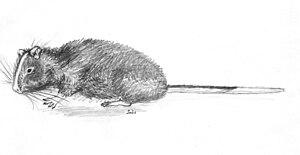Inca rats
| Inca rats | ||||||||||||
|---|---|---|---|---|---|---|---|---|---|---|---|---|

Machu Picchu Inca Rat ( Cuscomys oblativus ) |
||||||||||||
| Systematics | ||||||||||||
|
||||||||||||
| Scientific name | ||||||||||||
| Cuscomys | ||||||||||||
| Emmons , 1999 |
The Inca rats ( Cuscomys = mouse from Cusco ), also tree chinchilla rat called, are a genus of rodents in the family of chinchilla rat , which in South America occur. The two species of the genus are the Machu Picchu Inca rat ( Cuscomys oblativus ), which was originally only known through subfossil remains from an Inca grave near Machu Picchu examined in 1912 , was first photographed live in 2009 and until the introduction of the genus Cuscomys to Abrocoma and the Ashaninka Inca rat ( Cuscomys ashaninka ), which was described together with the genus, and is the type species of the genus. Both species live in the Cusco region in the southeast of the Peruvian Andes .
features
Inca rats are larger than the related Abrocoma species and show a clear adaptation to a tree-dwelling (arboreal) way of life. The condylobasal length is greater than 60 mm. Since one of the two species of the genus was known only from two skulls at the time the genus was described, only little information was given on the external appearance. The tail length is longer than three quarters of the head body length. The paws are broad, the toes strong and long and have strongly curved claws. The muzzle is long and strong and almost as wide as the interorbital region. The nose is also wide. The palatal bone is only slightly concave. A noticeable ridge runs along the bone suture between the two halves of the paired palatine bone. The ascending branch of the lower jaw is low. The bony warts between the occiput and parietal bone are small.
supporting documents
- ↑ a b Emmons, LH (1999). A new genus and species of abrocomid rodent from Peru (Rodentia: Abrocomidae) . American Museum Novitates 3279: 1-14. Page 2.